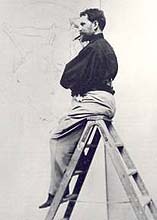| Biography of Alphonse Mucha (1860-1939) |
|

|
Mucha's role in cementing Art Nouveau in the public imagination is inseparable from his role as a posterist. Though he worked in furniture, stage decoration, jewelry, sculpture, crafts, and painting, no genre was as widely accessible to the ordinary viewer as the poster. It was the poster that made his reputation. The man who ultimately became synonymous with Art Nouveau might never have had such a commanding influence on the movement had it not been for his extraordinary work in posters. There he displayed all the rules he later expounded in his seminal work 'Documents Decorative' with such passion and mastery that not even traditionalists could argue that the line between fine and commercial art had been indelibly blurred.
Alphonse Maria Mucha was born in the village of Ivancice in what was then Austria, today the Czech Republic. Under the sponsorship of a German Count, Mucha studied art at the Munich Academy and later at the Academie Julian and the Academie Colarossi in Paris. Mucha survived there as an illustrator until December, 1894.
It was Christmas and the Theatre de la Renaissance needed a poster for a production starring the legendary Sarah Bernhardt. The holiday having drawn artists away from their studios, only Mucha was available to create the design. Appearing 4 years after Toulouse-Lautrec's success with 'Moulin Rouge,' Mucha's first poster, 'Gismonda,' dazzled the city. The interest in posters begun by Cheret and Lautrec became an obsession. Books on posters began to appear - four in a single year - and collecting began in earnest all over the world.
Sarah Bernhardt commissioned Mucha to design her posters, stage sets, costumes, and jewelry. She introduced him into society. Mucha himself became a Parisian celebrity. He entered into a contract with the printer Champenois under whose aegis he produced many of his most famous works.
In the early 1900s, Mucha spent time in America where he was warmly welcomed. He was commissioned to do a portrait of Ethel Barrymore, became close friends with the Tiffany family and was the guest of Theodore Roosevelt. A wealthy American industrialist and political activist put Mucha on a stipend that freed him from financial worries and allowed him to fulfill his ambition of returning to his native country. There his energies were put towards the decoration of public buildings, the preparation of posters for patriotic causes and the painting of a series of monumental canvases depicting the Slavic contribution to European culture.
During his lifetime, Mucha produced some 100 posters and decorative panels. While he inspired many other artists, no one has ever equaled his ability to infuse the ordinary with sumptuous beauty. His use of color, of organic form, of voluptuous detail create a mystical atmosphere where once was only a graphic design. |
|
|